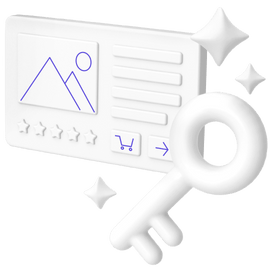Building an Unbeatable Amazon Bidding Strategy: Tips and Tricks

Amazon cost-per-click (CPC) is growing from year to year, but over the past few years, the increase has been hitting double digits. The average Amazon CPC back in 2020 was at $0.79, a year later, it had already hit $1.20.
Source: Statista
This means that as a seller who wants to advertise their product, you are more likely to encounter higher costs and potentially lower ROI. But this increasing cost of Amazon advertising can be negated by smarter Amazon ad strategies, and the biggest part of this is keyword bidding.
Amazon keyword bidding can be the make-or-break factor for your advertising performance. If your bids are too high, you will attract the traffic you need but at a cost that makes the effort not worth it. If too low—well, clearly, your bid will just never win and will open up opportunities for competing products.
That’s why you should really get into the ins and outs of Amazon keyword bidding—to launch profitable ad campaigns and supercharge your business goals.
The Amazon bidding strategy, however, is an art and science of its own—it can be challenging and time-consuming, especially for sellers that are just getting started with Amazon advertising.
This post will go through the key aspects of the Amazon keyword bidding strategy, revealing the top tips and tricks that can help you to bid the right way without overcomplicating the process.
Hi! This post is brought to you by Sellzone, a blog designed by Semrush to help your ecommerce business grow. Semrush is the online visibility platform trusted by seven million users and 30% of Fortune 500 companies. Take advantage of Semrush's ecommerce tools by entering Semrush AppCenter.
Follow us on social media to read the latest strategies from the ecommerce community, and don't miss new opportunities to increase your profits:
What Is Keyword Bidding, and How Does It Work on Amazon?
Before you dive into the specifics of Amazon keyword research, we suggest that you go through our post that covers everything you need to know about Amazon advertising. Because keyword bidding is essentially a part of Amazon PPC, familiarize yourself with the basics.
Now back to the Amazon keyword bidding strategy.
The majority of advertising efforts on Amazon revolve around keywords. Essentially, when a shopper looks up products on Amazon and clicks on an ad instead of an organic listing, the marketplace charges the seller on a per-click basis.
Whenever shoppers search for anything on Amazon, the marketplace launches a real-time CPC auction that establishes:
- Which ads will appear among the search results;
- The order in which the ads will appear.
The seller who had the highest bid for the relevant keyword wins the auction, and their product ad gets listed within the search results with a tiny “sponsored” label.
Now, what determines the price for the click?
Essentially, your competitors do. Amazon’s auctions typically follow the second-price auction rule, meaning that the highest bidder will only have to pay $0.01 more than the second-highest bidder.
This is how it works:
On top of this, Amazon also takes relevance into account, factoring in its own estimation of your projected CTR and conversion rates as well as general relevance to the shopper’s search query. This won’t get you winning bids all the time, but you can keep your costs down if you only launch campaigns for closely relevant queries.
As you can see, setting the right bid is the best thing you can learn to do for the success of your Amazon PPC campaign. So, let’s jump straight into the various Amazon bidding strategies.
How to Choose the Best Bidding Strategy on Amazon?
In this post, we’re unwrapping bidding strategies for the most popular type of Amazon advertising—sponsored product ads.
Sponsored product ads give you the option of choosing the type of bidding you want to apply to your ad campaign. Essentially, they fall into two bigger categories:
- Dynamic bids
- Fixed bids
Dynamic Bids — Down Only
For this bidding type, Amazon will lower your bid by up to 100% if a click is unlikely to convert.
Dynamic Bids — Up and Down
As you can tell from its name, this bidding strategy can lead to Amazon either increasing or decreasing your bid by 100%, depending on the likelihood of a conversion. For sponsored products, your bid will not go up by more than 100% (you can raise the increase by up to 900% in advanced settings) for the top of search spots and by up to 50% for the rest of the placements.
There are a few more bidding options that we will touch upon, but sellers mostly opt for these two.
Fixed Bids
As the name implies, your bid doesn’t change at all and doesn’t depend on conversion projections.
Now, before we explore each bidding strategy in more detail, keep in mind that your choice will largely depend on a few factors:
- Your advertising budget
- Your experience and savviness with various bidding types
- Your target TACOS (total advertising cost of sale), or how much you are ready to spend to trigger a sale.
Keeping these factors in mind, let's unwrap the key tips and tricks for each Amazon keyword bidding strategy.
Amazon Keyword Bidding Strategies: Useful Tips and Tricks
Play It Safe With “Dynamic Bidding - Down Only”
If you want to go for a safe bet, this is probably the strategy to go for.
So, if you’re an Amazon PPC newbie or don’t have large Amazon ads budgets, you’re probably better to opt for this strategy, as it:
- Reduces your ad cost
- Enables a profit-driven ad strategy (you only pay a higher bid if the chances of a conversion are also high)
- Helps to avoid inefficiencies (you don’t pay much for ads that don’t bring value)
If you’re still not confident about your ad campaign and want to go for a safe bet, this is probably the strategy to go for.
Tip: If you are going for manual keyword targeting and/or a product (ASIN) targeting campaign, you can get pretty exact with your bids. So don’t choose dynamic bidding in this case, because you have all the control over your campaign.
Trick: When you turn to auto and category targeting campaigns, however, this strategy will help you to avoid overspending your budget.
How so?
Well, let’s see how this strategy would work for your auto campaign. An auto campaign means that you have the same bid for any kind of keywords, regardless of their conversion potential.
For instance, you’ve set your bid at $2. This means that Amazon will take this bid for all the keywords you target with your ads, meaning that you will spend the same $2 on users who come with lower and higher purchasing intentions. The “Dynamic bids - down only” strategy will help you avoid spending $2 on a keyword that might only be worth $0.50. And this, in turn, will help you reduce your ACoS.
Take a Risk With “Dynamic Bidding - Up and Down”
The “Dynamic bidding - up and down” strategy is well-respected among Amazon experts for its high sales potential and efficiency.
But if you’re new to Amazon advertising, this bidding type might take up too much of your resources as you will have to keep a constant eye on your ad spend.
With this strategy, Amazon may up your bid by 100% for the top-of-search placements, and by 50% for the other ad spots. And this is where it’s both good and bad.
The good:
This strategy will likely lead to more conversions, aka sales, because you pay less for keywords that don’t convert, and more for keywords that do.
The bad:
But this means that you may have to double, triple, or quadruple your initial ad budget, and if you don’t keep a close watch, you might miss the time when you are really overspending.
Tip: Don’t use this bidding strategy for your usual ad campaigns. Instead, only opt for it when you need a strong and efficient brand defense campaign!
This means that when you see competitors trying to expand their market share by taking over yours—they may be bidding on your branded keywords or advertising on your product detail pages—that’s when this bidding type will help you stop them and defend your brand on Amazon.
Advertise New Products with Fixed Bids
If your product doesn't have a long sales history on Amazon, you can’t just get away with the safest “Dynamic bidding - down only” option.
Because while this is the safest and the smartest bidding type for those who aren’t very Amazon ads savvy, you might not enjoy its benefits if Amazon doesn’t know which keywords lead to conversions.
That’s when you turn to fixed bids. You have full control over your spending and have a chance to gather some data to run a campaign with “Dynamic bidding - down only” in the future.
Tip: While fixed bids are safe and help you spend exactly as much as you intend to spend, they may actually lead to higher ad expenses as you don’t get the downpricing from Amazon based on conversion potential. So only use this bidding strategy when you are launching ads for new products or when you’ve done your research very thoroughly and know exactly how much your bid should cost.
Suggested bids
Amazon itself gives you a ballpark number for your bids with Suggested bids.
This number comes from the marketplace’s internal intel that looks at the recent winning bids for products that are similar to the one you are about to advertise.
Experts are still debating whether you should follow Amazon’s numbers or not. On the one hand, you may think that it’s in Amazon’s interest to take as much money off you as possible. On the other hand, Amazon would want you to get plausible results from your ad efforts so you choose to continue advertising.
Tip: Don’t just follow Amazon’s suggested bid—take a close look at the number and if it’s in line with your target ACoS, then you can give it a try. If it’s too high, then come up with your own bidding strategy.
Keep watch on CPC
Whatever bidding strategy you choose to follow (well, apart from fixed bid when your CPC doesn’t change), one thing is always true—you have to keep a close eye on your CPC numbers.
If the CPC is growing, it may signpost that new players are entering the niche and you might have to up your bid to keep the target visibility benchmark intact.
If you see your CPC go down, it might indicate that your rivals are lowering their bids. You may think that’s great because you have an edge over competitors and will get to attract more traffic, but, actually, it might imply that you are overpaying for traffic that doesn’t convert, so watch out for that!
Consider Amazon AI
At this point, you might be slightly overwhelmed by the sheer variety of bidding strategies and find it challenging to manage it all by yourself.
That’s where an Amazon ad automation tool like PPC Optimizer for Amazon comes in.
In a nutshell, PPC Optimizer automates your bids, factoring in a lot of advertising aspects you might miss for making the right bidding decision—industry trends, historical data, and various parameters that might be hard to reconcile for sellers who don’t have vast experience with Amazon ads.
All you need to do is calculate your target ACoS.
It’s not the easiest task, but the tool will take care of the rest. But let’s take it one step at a time.
Calculating your target ACoS
Essentially, your end goal here is to understand your breakeven point, meaning you have to assess how much you can afford to spend on an ad for a given product, considering your selling price, buying cost, Amazon fees, and margins.
Let’s see how it works with a simple example.
Say, you’re selling whatever product on Amazon. This is what your cost structure will look like:
$30—the product’s selling price
$7—the cost of buying the product
$10—Amazon FBA fees
$3—other costs
Profit=$10
With this cost structure, your profit per piece equals $10. This means that for each sale you can spend $10 and still be profitable. This means that your target ACoS is
$10/$30 = 33%
For you as an advertiser, this implies that if your bid is within 0%-33% of your product price, you will still make a profit. Otherwise, your advertising efforts will only lead to losses.
Leveraging PPC Optimizer’s AI to launch smart Amazon ads
Here’s what you should do to get the tool’s AI to work in your advertising campaign’s favor:
- Once you have your target ACoS, overall budget, and campaign duration (this parameter can be changed) in mind, simply enter these initial campaign specs into the tool.
- This is where your job ends and the tool begins to work all by itself, choosing the best advertising strategy for your product.
How does it work exactly?
PPC Optimizer takes your basic specs into account and starts working its magic.
It creates four separate campaigns that find the top strategy for advertising your product: auto campaign harvests new high-performing keywords and product targetings; manual broad campaign finds mid-volume keywords that might enrich the semantic core; manual exact and product targeting campaigns combine the intel from the two previous campaigns and reallocate your budget to the top performers.
This way, the tool optimizes your campaign on the go, changing keywords, product targetings, and even bidding strategies—all to meet your entered specs (target ACoS, total budget, and duration).
Closing Remarks
As much as having the right bidding strategy can be the most decisive factor in your Amazon ad campaign’s success, there are other aspects that are no less important: Targeting the right keyword; promoting the right product.
Done together and done right, these factors can lead to a campaign that meets Amazon’s ad quality parameters, hence, bringing you lower CPCs, higher click-throughs and conversions.
And the way to get there is to keep testing your ads, analyzing your campaigns’ performance over time, and pinpointing your hits and misses.
That’s why most newbies find Amazon advertising pretty intimidating—there are indeed a lot of things to take care of.
Your manual ad campaigns can often lead to wasted budgets as you may choose the wrong bidding strategy or keywords. With tools like PPC Optimizer, however, you will always know that you are getting the maximum results out of your advertising efforts. And if you don’t find them satisfactory, it just means that you should switch to advertising a different product.
You've read to the end, you rock! Follow us on social media, and don’t miss new opportunities to increase your profits:
Read further:
If you want to know how to take a holistic approach to Amazon PPC and maximize the outcome of your efforts, turn to this post that reveals how to get more visibility and sales through Amazon advertising.



